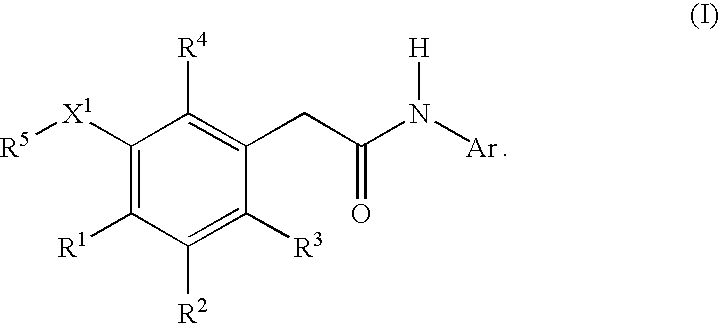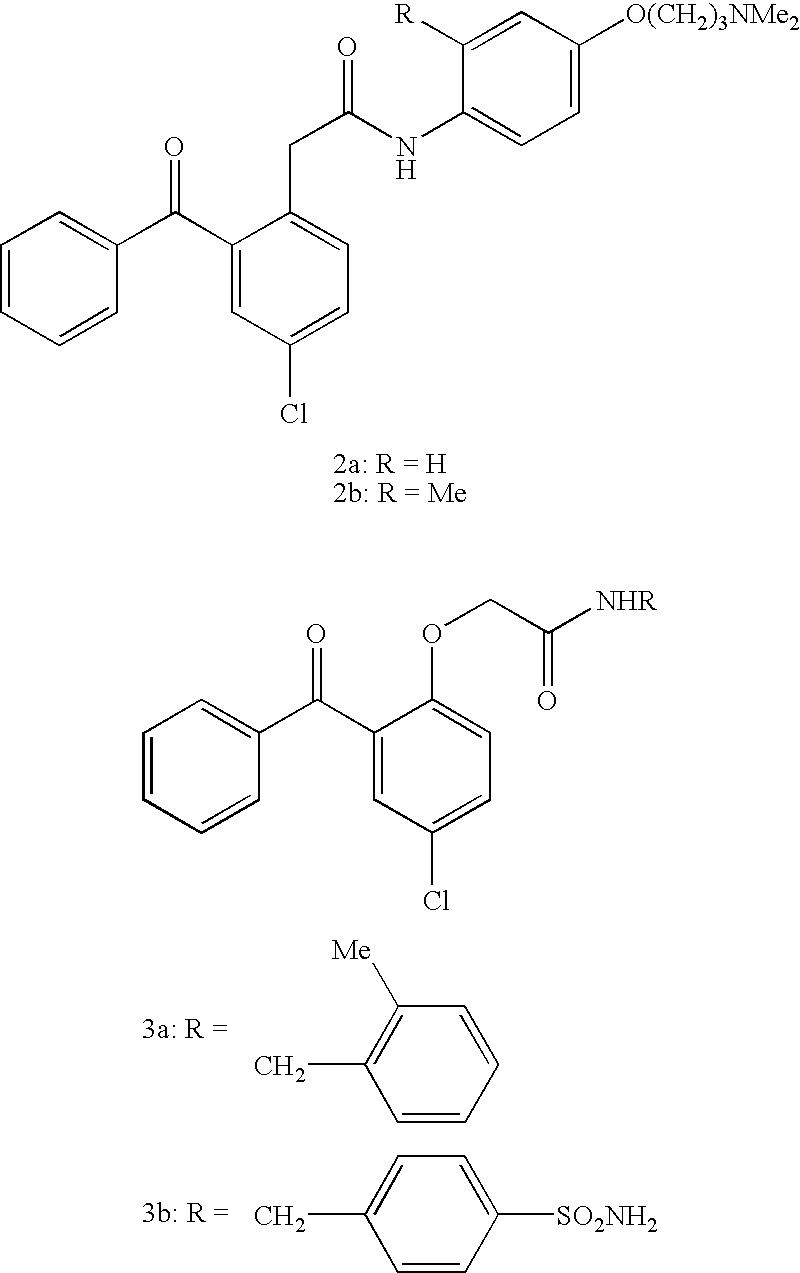Non-nucleoside reverse transcriptase inhibitors
a reverse transcriptase and non-nucleoside technology, applied in the field of antiviral therapy, can solve the problems of slowed disease progression, significant therapeutic problems remain, and viral loads, and achieve the effects of reducing susceptibility to therapy, broad spectrum of activity, and inhibiting hiv reverse transcriptas
- Summary
- Abstract
- Description
- Claims
- Application Information
AI Technical Summary
Benefits of technology
Problems solved by technology
Method used
Image
Examples
example 1
2-[4-Chloro-3-(3-chloro-5-cyano-phenoxy)-phenyl]-N-(4-sulfamoyl-phenyl)-acetamide (I-1)
[0199][0200]step 1—A solution of 4-chloro-3-methoxytoluene (36; 0.5 g; 3.2 mmol), NBS (0.57 g; 3.2 mmol) and benzoyl peroxide (0.031 g; 0.13 mmol) and 32 mL of DCE were heated at reflux for 3 h. The reaction mixture was cooled, diluted with CH2Cl2 and washed with water and brine. The organic extract was dried, filtered and evaporated to yield the bromomethyl compound 38b which was used without further purification.[0201]step 2—The 28 g (0.166 mmol) of 38b from the previous step, NaCN (28 g; 0.58 mmol; 3.5 equiv.) 500 mL of 90% aqueous EtOH were stirred at room temperature overnight. The crude residue was partitioned between EtOAc / H2O (359 mL of each), washed with brine, dried, filtered and evaporated. The crude product was purified by SiO2 chromatography eluting with a EtOAc / hexane gradient (100% hexane to 90% hexane) to afford 21 g of 38c.[0202]step 3—Gaseous HCl was slowly bubbled into a cooled ...
example 2
2-[3-(2-Bromo-5-chloro-phenoxy)-4-chloro-phenyl]-N-(4-sulfamoyl-phenyl)-acetamide (I-4)
[0209][0210]step 1—A solution of phenol 59c (2.0 g, 9.32 mmol), 1-bromo-2-fluoro-4-chloro-benzene (1.28 mL, 2,15 g, 10.25 mmol), K2CO3 (3.84 g, 30 mmol) and NMP (20 mL) was stirred and heated to 130° C. for 8 h. The reaction mixture was cooled to RT and diluted with H2O (50 mL) and twice extracted with EtOAc. The combined organic extracts were washed sequentially with water (6 times) and brine, dried (Na2SO4), filtered and concentrated in vacuo. The crude product was purified by SiO2 column chromatography eluting with (10% EtOAc / hexane) to afford 0.328 g (% theory) of I-4.[0211]Steps 2–4 were carried out as described in steps 7–9 of Example 1 which afforded I-4
[0212]Compound I-3 was prepared in the same manner except in step 4, 4-amino-benzenesulfonamide was replaced by 3-(4-amino-3-methyl-phenoxy)-propane-1-sulfonic acid amide (J. H. Chan et al. J. Med. Chem. 2004 47(5): 1175–1182).
example 3
2-[4-Chloro-3-(4-cyano-2,6-dimethyl-phenoxy)-phenyl]-N-4-sulfamoyl-phenyl)-acetamide (I-55)
[0213][0214]step 1—A solution of 40 (0.600 g, 2.79 mmol), 3,5-dimethyl-4-fluorobenzonitrile (41, 0.459 g, 3.07 mmol), K2CO3 (1.157 g, 8.37 mmol) and NMP (6 mL) was stirred and heated to 120° C. for 6 h. When the starting material was consumed the solution was cooled and acidified with 10% HCl and twice extracted with EtOAc. The combined extracts were washed sequentially with water and brine, dried (Na2SO4), filtered and evaporated in vacuo. The crude product was purified by SiO2 chromatography and eluted with an EtOAc / hexane gradient (100% hexane to 50% hexane) to afford 106a.[0215]Steps 2–4 were carried out as described in steps 7–9 of Example 1 which afforded I-55.
[0216]Compound I-56 was prepared using a similar procedure except in step 4, 4-amino-benzenesulfonamide was replaced with 4-amino-2-methyl-benzenesulfonamide.
[0217]Compound I-68 was prepared using a similar procedure except in step...
PUM
| Property | Measurement | Unit |
|---|---|---|
| temperature | aaaaa | aaaaa |
| temperature | aaaaa | aaaaa |
| temperature | aaaaa | aaaaa |
Abstract
Description
Claims
Application Information
 Login to View More
Login to View More - R&D
- Intellectual Property
- Life Sciences
- Materials
- Tech Scout
- Unparalleled Data Quality
- Higher Quality Content
- 60% Fewer Hallucinations
Browse by: Latest US Patents, China's latest patents, Technical Efficacy Thesaurus, Application Domain, Technology Topic, Popular Technical Reports.
© 2025 PatSnap. All rights reserved.Legal|Privacy policy|Modern Slavery Act Transparency Statement|Sitemap|About US| Contact US: help@patsnap.com



